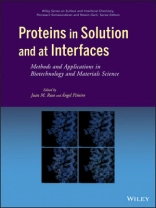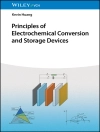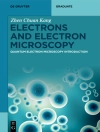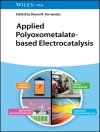Explores new applications emerging from our latest
understanding of proteins in solution and at interfaces
Proteins in solution and at interfaces increasingly serve as the
starting point for exciting new applications, from biomimetic
materials to nanoparticle patterning. This book surveys the state
of the science in the field, offering investigators a current
understanding of the characteristics of proteins in solution and at
interfaces as well as the techniques used to study these
characteristics. Moreover, the authors explore many of the new and
emerging applications that have resulted from the most recent
studies. Topics include protein and protein aggregate structure;
computational and experimental techniques to study protein
structure, aggregation, and adsorption; proteins in non-standard
conditions; and applications in biotechnology.
Proteins in Solution and at Interfaces is divided into
two parts:
* Part One introduces concepts as well as theoretical and
experimental techniques that are used to study protein systems,
including X-ray crystallography, nuclear magnetic resonance, small
angle scattering, and spectroscopic methods
* Part Two examines current and emerging applications,
including nanomaterials, natural fibrous proteins, and biomolecular
thermodynamics
The book’s twenty-three chapters have been contributed by
leading experts in the field. These contributions are based on a
thorough review of the latest peer-reviewed findings as well as the
authors’ own research experience. Chapters begin with a discussion
of core concepts and then gradually build in complexity, concluding
with a forecast of future developments.
Readers will not only gain a current understanding of proteins
in solution and at interfaces, but also will discover how
theoretical and technical developments in the field can be
translated into new applications in material design, genetic
engineering, personalized medicine, drug delivery, biosensors, and
biotechnology.
قائمة المحتويات
PREFACE ix
CONTRIBUTORS xiii
PART I
1 X-Ray Crystallography of Biological Macromolecules:
Fundamentals and Applications 3
Antonio L. Llamas-Saiz and Mark J. van Raaij
2 Nuclear Magnetic Resonance Methods for Studying Soluble,
Fibrous, and Membrane-Embedded Proteins 23
Victoria A. Higman
3 Small-Angle X-Ray Scattering Applied to Proteins in Solution
49
Leandro Ramos Souza Barbosa, Francesco Spinozzi, Paolo Mariani,
and Rosangela Itri
4 Analyzing the Solution State of Protein Structure,
Interactions, and Ligands by Spectroscopic Methods 73
Veronica I. Dodero and Paula V. Messina
5 Resolving Membrane-Bound Protein Orientation and Conformation
by Neutron Reflectivity 99
Hirsh Nanda
6 Investigating Protein Interactions at Solid Surfaces–In
Situ, Nonlabeling Techniques 113
Olof Svensson, Javier Sotres, and Alejandro Barrantes
7 Calorimetric Methods to Characterize the Forces Driving
Macromolecular Association and Folding Processes 139
Conceic¸ ~ao A.S.A. Minetti, Peter L. Privalov, and
David P. Remeta
8 Virtual Ligand Screening Against Comparative Models of
Proteins 179
Hao Fan
9 Atomistic and Coarse-Grained Molecular Dynamics Simulations of
Membrane Proteins 193
Thomas J. Piggot, Peter J. Bond, and Syma Khalid
PART II
10 Preparation of Nanomaterials Based on Peptides and Proteins
209
Yujing Sun and Zhuang Li
11 Natural Fibrous Proteins: Structural Analysis, Assembly, and
Applications 219
Mark J. van Raaij and Anna Mitraki
12 Amyloid-Like Fibrils: Origin, Structure, Properties, and
Potential Technological Applications 233
Pablo Taboada, Silvia Barbosa, Josue Juarez, Manuel-Alatorre
Meda, and Vyctor Mosquera
13 Proteins and Peptides in Biomimetic Polymeric Membranes
283
Alfredo Gonzalez-Perez
14 Study of Proteins and Peptides at Interfaces By Molecular
Dynamics Simulation Techniques 291
David Poger and Alan E. Mark
15 A Single-Molecule Approach to Explore the Role of the Solvent
Environment in Protein Folding 315
Katarzyna Tych and Lorna Dougan
16 Enhanced Functionality of Peroxidases By Its Immobilization
at The Solid-Liquid Interface of Mesoporous Materials and
Nanoparticles 335
Jose Campos-Teran, Iker Inarritu, Jorge Aburto, and Eduardo
Torres
17 Superactivity of Enzymes in Supramolecular Hydrogels
353
Ye Zhang and Bing Xu
18 Surfactant Proteins and Natural Biofoams 365
Malcolm W. Kennedy and Alan Cooper
19 Promiscuous Enzymes 379
Luis F. Olguin
20 Thermodynamics and Kinetics of Mixed Protein/Surfactant
Adsorption Layers at Liquid Interfaces 389
Reinhard Miller, E.V. Aksenenko, V.S. Alahverdjieva, V.B.
Fainerman, C.S. Kotsmar, J. Kragel, M.E. Leser, J.
Maldonado-Valderrama, V. Pradines, C. Stefaniu, A. Stocco, and R.
Wustneck
21 Application of Force Spectroscopy Methods to the Study of
Biomaterials 429
Chuan Xu and Erika F. Merschrod S.
22 Protein Gel Rheology 437
Katie Weigandt and Danilo Pozzo
23 Exploring Biomolecular Thermodynamics in Aqueous and
Nonaqueous Environments using Time-Resolved Photothermal Methods
449
Randy W. Larsen, Carissa M. Vetromile, William A. Maza, Khoa
Pham, Jaroslava Miksovska
INDEX 473
عن المؤلف
JUAN M. RUSO is currently Associate Professor in the
Department of Applied Physics at the University of Santiago de
Compostela, Spain. He has contributed to more than 100 publications
on a broad range of physical, chemical, and biophysics studies. His
research interests include protein ligand interactions, thermal
stabilization of protein, Phase behavior, and self-assembly
processes in soft matter systems, biocompatible materials design,
and nanocarrier design for targeted drug delivery.
ÁNGEL PIÑEIRO is an IPP Research Fellow at the
Department of Applied Physics of the University of Santiago de
Compostela, Spain. His current research interests include the
design and characterization of self-assembled systems as well as
the study of macromolecules in solution, embedded in membranes or
at interfaces. His work is mainly based on computational methods
including multiscale molecular dynamics simulations and the
development of software for the analysis of different experimental
properties.












